
Kitty Taniguchi with her Wrong Horrizon Painting at the CCP
KITTY TANIGUCHI’S QUINTESSENTIAL FEMININE AESTHETIC
by: Christiane L. de la Paz
May-June 2010--Kitty Taniguchi is among the few female painters who had successfully trespassed upon a male-controlled territory. For the past thirty years, she has faithfully explored themes of femininity and feminine modes of representations that challenge and reinterpret some existing social and cultural conventions. Many of her works are drawn from her experiences and her portraits of women may be read as the truth, reality, challenges and sufferings of women through centuries of spiritual and physical oppression and even more so her personal struggle to define her own artistic identity. Symbolism likewise pervades in her works as a way of replacing traditional representations and to give substance to her content. Kitty Taniguchi tells in this interview the beginning of her artistic career, the sources of her artistic style and production and why her works hold a place in the history of Philippine art.
Since graduating from Silliman University in 1978, how was your life like during the early phase of your career?
In the 80s, my life was rather good and not so good. I mixed marriage, teaching, getting through a master’s degree, mothering to my daughter Maria who I gave birth in 1981, and art making. I also faced two major court cases against the biological father of Maria and some other business related court cases. Much more I had to balance a life with my own family, especially my mother whose perception in life is rooted with traditions. Most often, this was my usual complain to myself and to some confidantes whom somehow I felt are locked up with “anything that hits” me on both personal and family level.
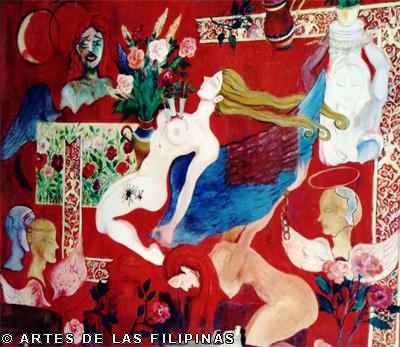
Banshee 2 (early 1990s)
So, you were married a few years after you graduated from college?
Marriage to me was just born out of “consequential direction,” try and accept, if not discard and ignore. I was just lucky that Kaoru Taniguchi just got an admirable patience to put up with situations. The Buddhist in him must have some bearing about this but I felt so strongly then that he was wondering why he decided to marry me when he could have opted to live his life as what he perceived it to be, that is, to live alone perhaps -- away from his wife which was 98 percent of his married life. Until now I kept thinking, “Who had been difficult to deal with? Someone like me? Kaoru? or my family? The early phase of my career was lived on daily basis. It was about dealing with problems; nothing long shoots.
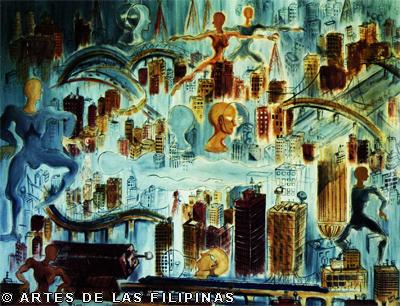
Blue Skyscrapers and Human Figures (1993)
Is Karou Taniguchi a Japanese national studying in Dumaguete?
Kaoru is a businessman I met at Iligan Cement Corporation Inc.
From 1978-1980, were you using the family name of your first husband in signing your canvas?
No. I only used Kitty.

Blue Dancers Series (1993)
How would you describe or characterize your works during this period?
I was not producing then for serious intentions. I was rather pre-occupied with my job at ICC. I was with the company up to 1981.
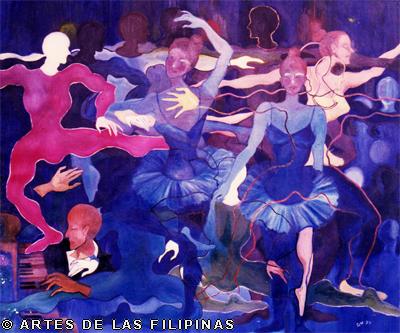
Heroes and Dancers Series (Blue Dancers) (1994)
How about the style of your works? How did it develop?
I think it just comes naturally. I am not conscious about style. I am more conscious about what my mind demands that I do on canvas. I like something that transcends. I think this is what dictates my style.
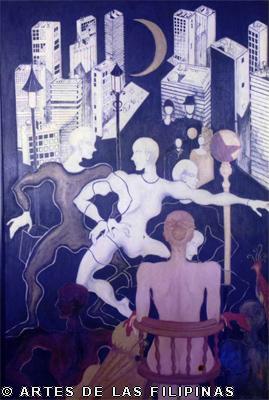
Paper City Series (Nude in the Park) (1994)
Was Fine Arts your first course?
No. I finished my Bachelor in Mass Communication in 1978 and a Masters in English Literature in 1985 in Silliman University.
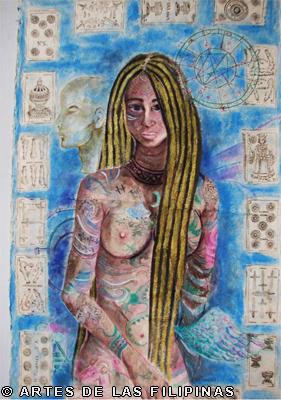
Lady with Tattoo (1996)
What made you decide to pursue fine arts?
I think being in the circle is but a destiny. Even when little my time was given mostly to creativity.
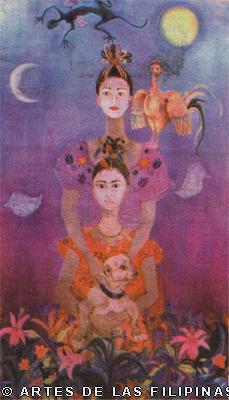
Artista Filipino 2 (2000)
Who are your contemporaries?
Do you mean in the circle? I got to exhibit with Karen Flores, Francesca Enriquez and Yasmin Almonte. This was for May Datuin’s project on emerging women artists and who owns women’s bodies in the late 1980s or early 1990s.

The Virgin (2000)
What was the first job you applied for?
I graduated in March 1978 and the following month I got a job in Iligan Cement Corporation, Incorporated in Kiwalan, Iligan City. My job was a PR clerk, in charge of writing and editing the company’s organ, organizing and budgeting for sports and entertainments and acting as a liaison for the company.
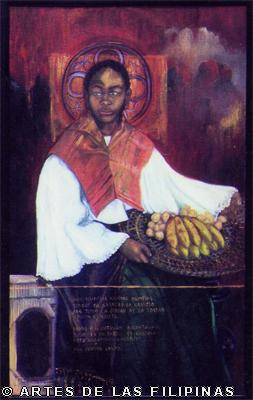
The Virgin (2000)
After this stint, did you have another job?
I was with Iligan Cement Corporation from 1978 to 1981 but with all my personal troubles during that time, I decided to leave my job and go to Silliman University to pursue a graduate course and teach. I taught at Silliman University as a part-time instructor while doing graduate and post graduate studies, which by the way I did not get to finish, and art making. I was also with CVPC which is now known as the Negros Oriental State University, from school year, 2000-2001. Just this second semester of 2009-2010, I taught Art Workshop theory based at the Foundation University. Outside university and studio work, I give consultation services on art and culture.
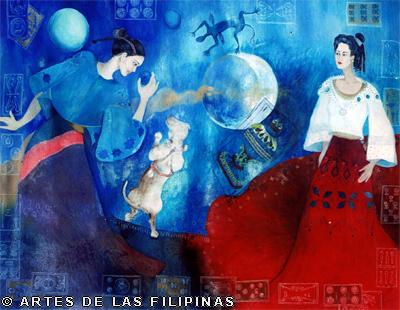
Maria Itaru and the Green Dragon (2000)
You first entered the art scene during the 1980s, what is the status of the art scene during those time?
As a region-based artist, living in a quaint community, it’s difficult to break into the mainstream in those days. Local art activities were rare if not well-defined. Access to possibilities of just even connecting and getting good chances to exhibit in the capital was usually hampered by the absence of good system of communications. Much more it was hard to find good materials to work with. What was a little bit good then was, occasionally, art organizers or art visionaries would be dropping by the city and try rounding up artists. For myself, I was doing independent art making and by 1992, I established Mariyah Gallery Restaurant despite the fact that it appeared that the community was not ready for an artist’s space. Its first name was Galleria Maria Cristina.
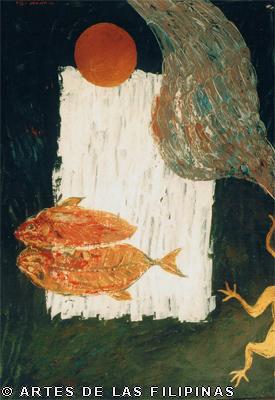
Fish and Wings (2000)
What did you wish to accomplish in putting up Mariyah Gallery Restaurant?
It was a restaurant with an art gallery. Mariyah Gallery is located at the outskirt of the city. The restaurant could help draw in viewers. In 2000, I closed the restaurant to focus more on my art making.

Mother and Child (2001)
Where do you buy your materials back then?
When I travel I buy art materials. Also I connect with suppliers in Manila.
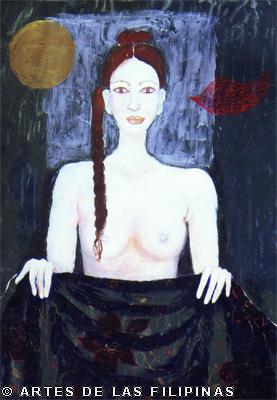
I Think I Like It (2002)
Tell me about your first exhibit.
In the early 1980s, I put up a double exhibit with my brother, Danni at the Silliman University Campus. It was good. We were appreciated. I knew then that we showed good works and that marked the beginning of my professional life in the circle.
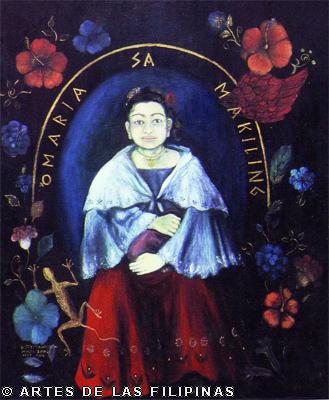
Maria sa Makiling (2002)
How would you differentiate your works from your brother?
Danni likes to do pen and ink. He is also a Mass Com graduate but later he decided to study anthropology. He is also a scuba diver. His subject matter has something to do with his interest. He is into sculpting too most of the time and uses different materials like terracotta, cement, wood and stone.
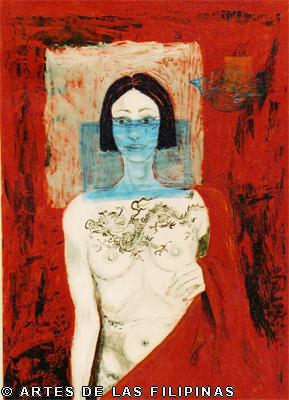
I Think I Like It #2 (2002)
What was the first gallery that carried your works?
In Makati, Gallery 111 of Ayala Museum where I mounted my second solo exhibit titled, “Heroes and Dancers.” My first solo exhibit was at De La Salle University, curated by Alex Umali through the recommendation of Chit Balmaceda.
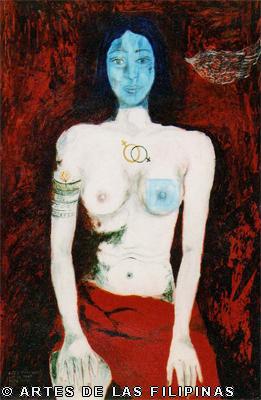
I Think I Like It #3 (2002)
For the ideas of your succeeding exhibitions, how do you try to be different in concepts and executions?
I was born with a talent of extended imagination just like any artist probably. I spent most of my childhood in convents and churches. My educational background is literature which allowed me to sharpen my insights and intellect and where I got to draw my philosophy and qualify life. I am also partial to new projections, new mind sets. I also like to see life’s realities and conventions juxtaposed, if not side by side, with let’s say not so “common essences,” may this be executed on canvas or other art forms. I like additions and more imaginations to challenge realities and conventions. I also do rethinking. I think any artist can play with institutional boundaries that pertains to creativity. After all, rules in art making could grow to the brim for an artist to accept and discard.

I Think I Like It (2002)
If any, did you ever find yourself in a situation when your idea for your own exhibit has been executed by another artist?
Ideas overlap somehow but it is how you grip an idea that makes it different or unique.
Do you try to improve this idea for your next exhibit or do you come up with a new one?
When I’m done with the idea, which is usually in series, I do new ones. Or else, I continue doing the same idea on related series until I saturate it.
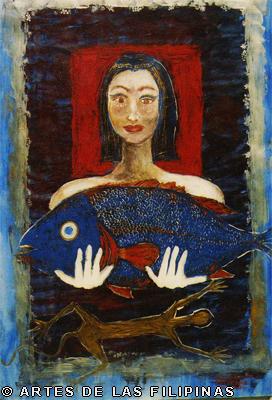
Fish Tale With Big Lizard (2003)
When you are in the process of working, who exactly is the viewer you have in mind?
Believe it or not, the first viewer is myself.

Maria sa Makiling (2002)
Do you agree that the first exhibit of a painter can make or break his career? Did this apply to you?
I think it is really a make or break.

Crow Rebellion (2003)
Are you a member of any artist’s group?
I am a free artist.
Have you ever won any important awards?
Yes. I have some distinctions.
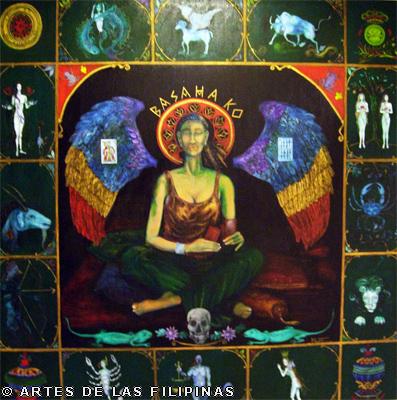
Basaha Ko (Read My Life)
Do you think awards help make a painter become commercially recognized? Does this help in the value placed in the succeeding works after winning an award?
It is difficult. Awards can help popularize an artist but awards are hardly pre-requisites for me. Besides, it also depends on who is giving the award.
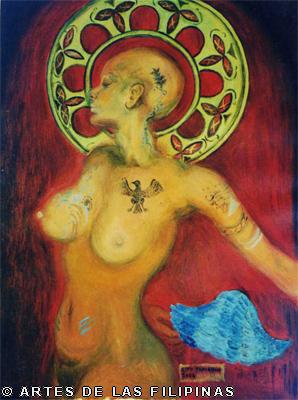
Kama Sutra #2
Whose style are you drawn to painting during your student years?
I started both painterly and linear. I enjoy the work of Picasso until now and admire the mind and passion of Frida Kahlo.
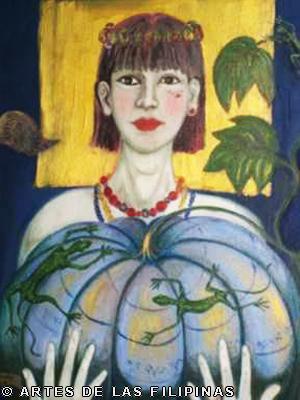
Offering (2004)
Since the time you began making art, has your style changed or has it remained the same?
I think I am very inconsistent. I thrive in inconsistencies. What is being demanded by my psyche dictates the projection that I do for my art. In my early years in art making, I was enamored with black, red and gold. It was kind of about the colors that I use but with this I was bringing in a subject matter which I think is significant. It took me some time to use other colors. Intuition has also been part of my art making but I am conscious of my intentions, too. I do picture with an aim to bring out some kind of discourse. But the thing is I am not the type of artist that literally slams the issue on the face of the viewer. There was a time when I got so tired of people asking about meanings of what I do. I always hate being asked about the meanings of my work. I find this too “boxy.” I did studies for a series for future project I titled Ballerinas and Domestic Animals. My intention for this project was of course to draw in some kind of intellectualization, not meaning. For this project, I also like to see textures, lines, blotches of colors, opposites and whatever please my psyche. This is actually what I have been up to now and then when I do some series of works. I am not assigning a definite meaning to what I’m doing. When I attempt to force out meanings from my work, I feel that I’m limiting its intellectual possibilities.
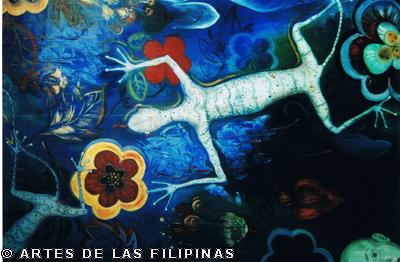
Blue Lizards (2004)
Why do you think that it limits your works’ intellectual possibilities?
Because I find it ridiculous trying to meat out explanations and give meanings to my works. I did a series titled In Search of the Crow and of course the bird is always present in this number of work. With all seriousness, indeed the title of course is already suggesting the methapor so some individuals would find connectivity between the bird and I and my life and my historicity which I think is also valid. I even did a number of pages articulating the bird in my work but later I decided to discard the bird. With all honesty, there were and there are points in my art making when I include objects and figures just to meet my aesthetic requirement but this doesn’t mean intellectuality is absent.
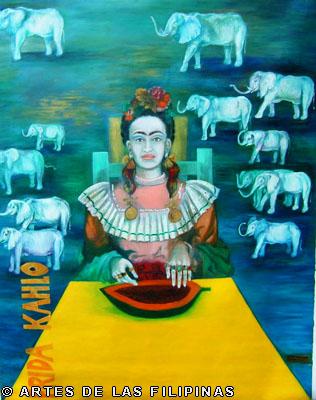
Frida Kahlo (2004)
How do you try to impart the meanings of your works to viewers who could not think in your level?
As much as possible, artists to some degree have a responsibility to make art understandable to its viewers. Please pardon me for thinking like this but the thing is art is more suited to intellectuals where its discourse can be well taken.

Chakra (2004)
Who handles the business side of your profession?
I do. Once in a while I get assistance from friends.
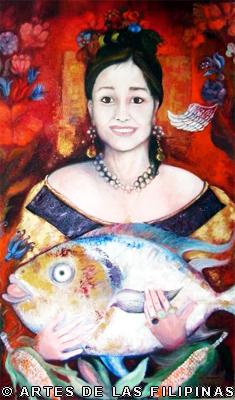
Kitty (2005)
What are the factors that you consider in pricing your works?
Materials and related expenses, time, aesthetics, relevance, circumstance.
Do you maintain these criteria even if your buyers are from abroad?
Yes.
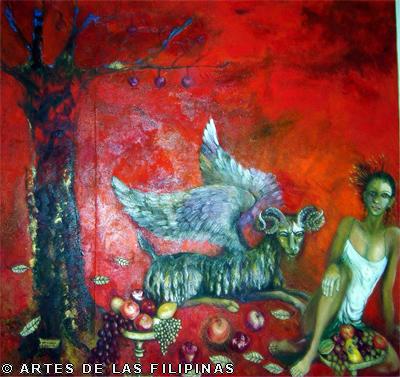
Evesian Dream No.1 (2006)
What has been the best compliment said about you or your work?
I’ve got many compliments about my work now and then but I guess what I like best is when Beijing International Art Biennale collected my two large works and told me that they really like my work and much more when one huge foundry company owner in China told me in the middle of a lunch break and with a bottle of beer that I am one of the best woman artists in China. Apparently, he must be kidding or humoring me but for me that was the best compliment I received as an artist.
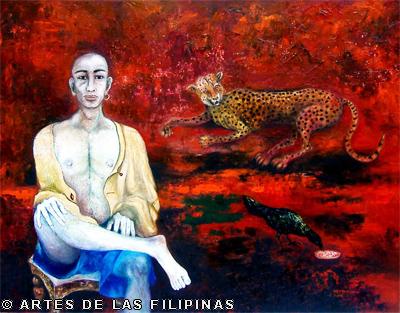
Buddha, His Cheeth and His Crow (2006)
And what have you been criticized of?
I’m criticized for going into organizing art events and activities when I’m supposed to only do art.
Can artists be told on what to do?
I listened to comments. I accept commissioned works and they are mostly tailored to what the client wants. I appreciate suggestions.
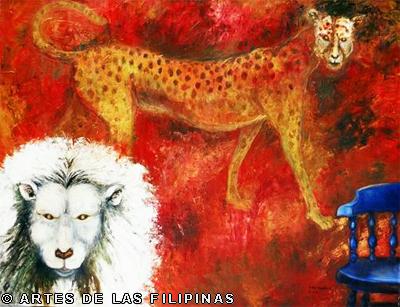
Lion, Cheetah and Blue Chair (2006)
You have been around the past 30 years, what have been the changes in the art scene from then and now?
I think the art scene has become progressive in terms of marketing here and abroad. Art has become a new industry. Artists are more adventurous and professional. Direction is more or less liberalized. Although looking closely, it is observable that a big percentage of artists are generally trying to catch up with trendy direction in the market arena. Young minds are more confident and competitive and they know what they want. Here in the region, it has become easier to compete. New tools are well placed for the artists to make use. Isolation is no longer a term. Collectors have more money to invest on art. There is some kind of awareness for those who have more than enough collections to establish their own private museums. Of course, contemporary projections are selling.
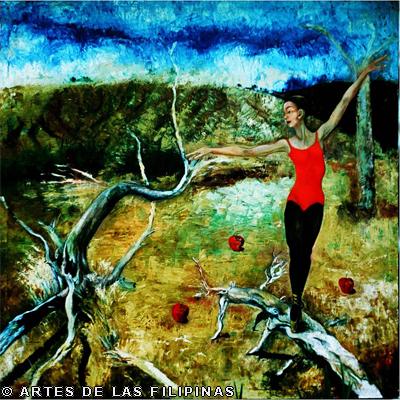
Ballerina and Apples (2007)
Can you pinpoint some of the positive changes that you observed?
Market is present. Universities in the region started opening fine arts school.
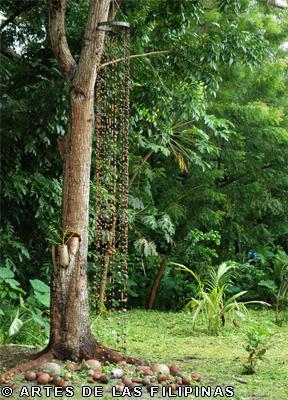
Rain Forest (2007)
What about the not so positive ones?
There are lots of pathetic politics.
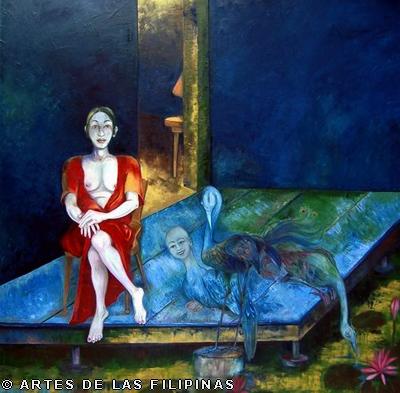
My Sister is a Bird (2008)
Of course, young artists are making big waves in the art scene today, what can these artists learn from your experiences as an artist?
This is their period and they must be honest about it. Only real players survive in this circle.

Tautology of Race #2 (2008)
How was it like raising a family and being an artist at the same time?
There’s nothing unusual about being an artist and having or raising a family. It’s just simply about managing time. Laziness has no place in this field when one’s situation is normal. But who can tell if a situation is really normal? Life could be very complicated and I think art is not really responsible for this. I would like to think that life with me and my family is both borderless and sometimes boxed.
Maria, your daughter is also an artist like you, have you always encouraged her to become a professional artist?
Maria was raised in an environment where art is present. I guess, it helps mold some kind of milieu for her. I don’t interfere or impose.

Tautology of Race #2 (2008)
In what way does your art differ from that of Maria?
Very different and perhaps with all modesty, Maria is schooled. She has entirely a different cosmos in art making. I remember her one time telling me that I might have presumed that I know her generation’s reality or even her own reality but I cannot presume. Totally, there’s no space to presume that I can fathom their way of thinking. I can only guess perhaps.
Where are your parents from?
My parents are from Panay Island. My father is from Ilo-ilo. My mother is from Kalibo, Aklan.
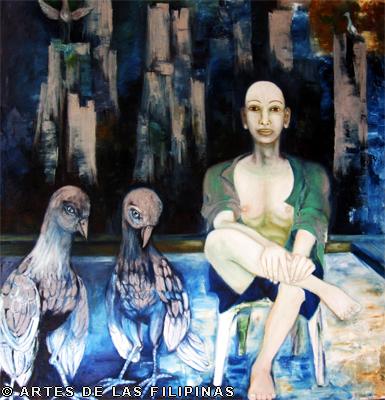
Sending Off The Crow and Buddha in the City (2008)
How were you introduced to art when you were growing up?
When I was about two to three years old, I would entertain my little relations with sketches and stories. I always had pad papers and pencils with me, courtesy of my father. He is my first mentor. He even allows me to cut his magazines’s colorful pages for me to make into paper dolls. He buys me watercolors and crayons and tells me it doesn’t matter if the color of the arms is purple and doesn’t mind if I destroy the ring and bracelet that he buys for me so I can make it into another thing that I want.

Winged Lover (2009)
As a student were you aware of how the professional art system worked?
I think I had ideas. I read books and accounts on the art scene then.
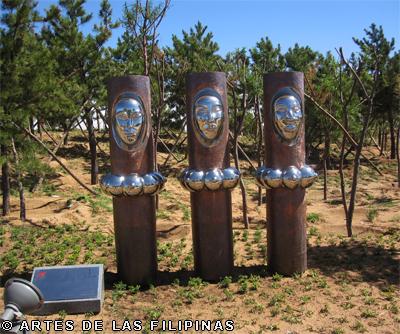
The Nurturers (2009)
Inner, Mongolia
Who are some of the people who have influenced you in your development as an artist?
I met May Datuin, the late Bobby Valenzuela, Imelda Cajipe-Endaya, Brenda Fajardo, Chit Balmaceda, Patrick Flores, Rochit Taňedo, fellow artist Karen Klores, and other cultural and art personalities in Manila. I think they all have contributed to my consciousness that art making is well worth to pursue.
Did you have any role models that you were somehow trying to emulate?
None. I just really want to do what I want. Now and then, I do projects with art organizers. I enjoy working with them but when it’s over, I prefer to be in my own corner.
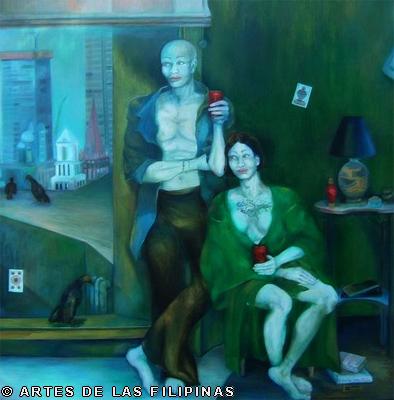
What countries have your art taken you?
I was in China three times. I was with Beijing International Art Biennale in 2005 and 2008. I join the sculpture creating camp in Beijing and was in Ordos Inner Mongolia for the 11th Asia Arts Festival in 2009. I was in Philadelphia and New Jersey in 2006 for an exhibit, workshop and lecture. I enjoyed travelling inland in amazing places here and the art exchange with other artists of the world. I think I really made good in representing my country for each trip.
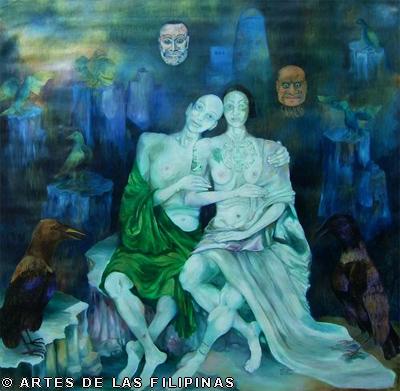
Let’s say, your art making did not work to your advantage, do you have a back up profession?
Yes. I can always go back to the university to teach. I can go back to little businesses like restaurant, sari-sari store. Besides, art has a very wide horizon. Another thing that I’m thinking is design and production of furniture, craft items and even textiles. Yet, this is the least I should think about.
Do you think that your works will hold a place in the history of Philippine art?
This is what every artist should aim. I always hope. I think what I have been doing is relevant and I too deserve to have a place in our art history.

Wrong Horizon (2006)
Recent Articles
.png) FILIPINO ART COLLECTOR: ALEXANDER S. NARCISO
FILIPINO ART COLLECTOR: ALEXANDER S. NARCISOMarch 2024 - Alexander Narciso is a Philosophy graduate from the Ateneo de Manila University, a master’s degree holder in Industry Economics from the Center for Research and...
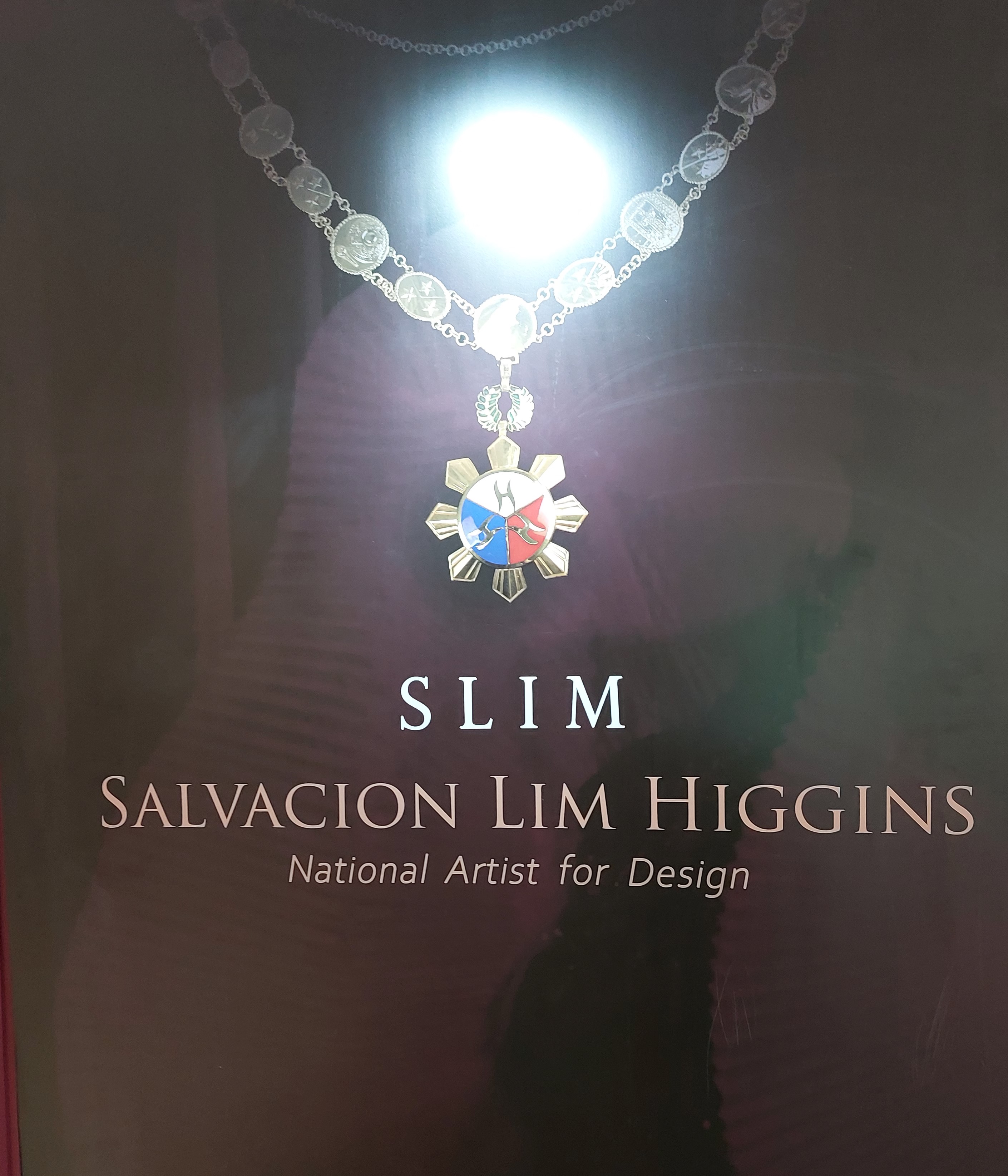 An Exhibition of the Design Legacy of Salvacion Lim Higgins
An Exhibition of the Design Legacy of Salvacion Lim HigginsSeptember 2022 – The fashion exhibition of Salvacion Lim Higgins hogged the headline once again when a part of her body of work was presented to the general public. The display...
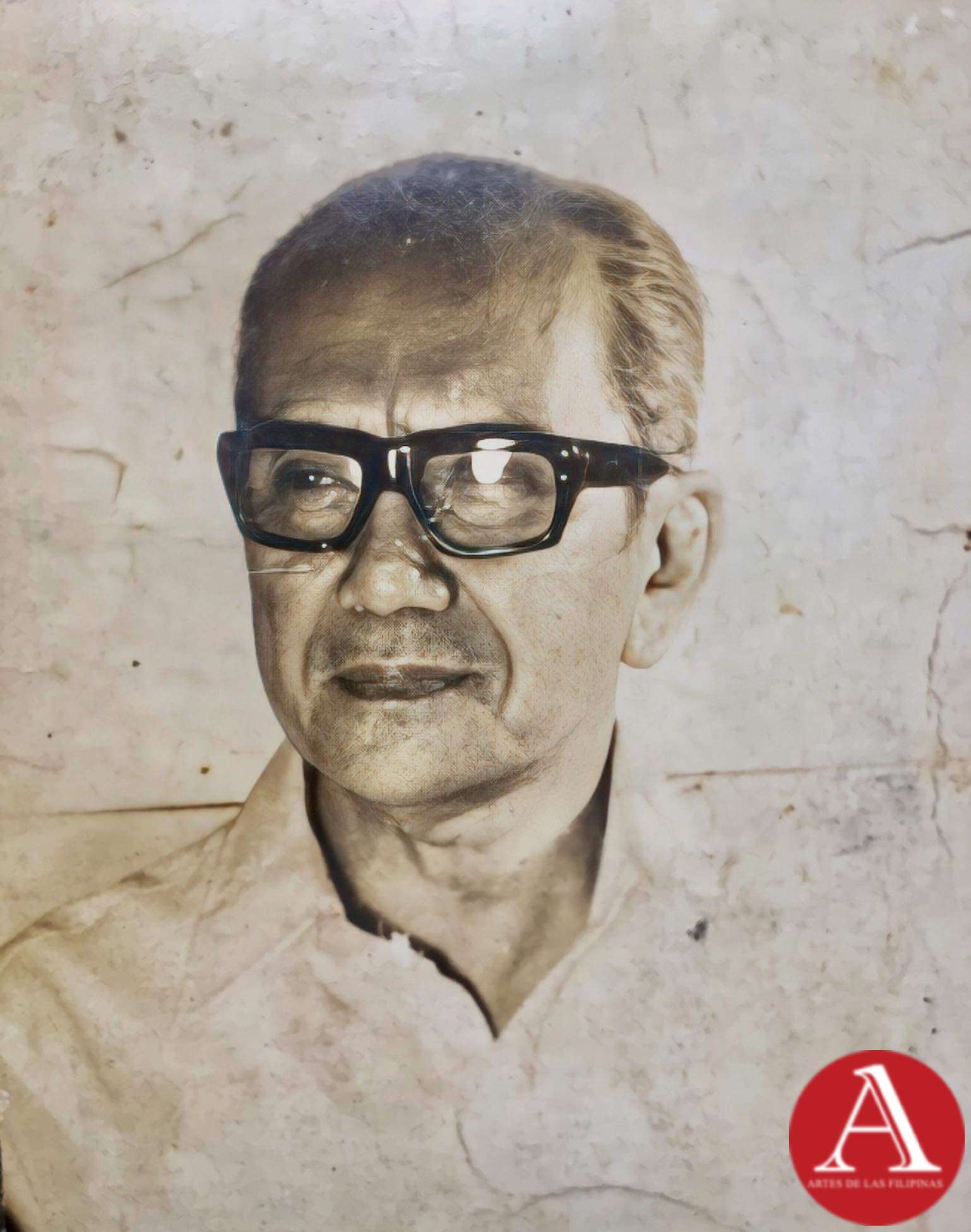 Jose Zabala Santos A Komiks Writer and Illustrator of All Time
Jose Zabala Santos A Komiks Writer and Illustrator of All TimeOne of the emblematic komiks writers in the Philippines, Jose Zabala Santos contributed to the success of the Golden Age of Philippine Komiks alongside his friends...
 Patis Tesoro's Busisi Textile Exhibition
Patis Tesoro's Busisi Textile Exhibition
The Philippine Art Book (First of Two Volumes) - Book Release April 2022 -- Artes de las Filipinas welcomed the year 2022 with its latest publication, The Philippine Art Book, a two-volume sourcebook of Filipino artists. The...
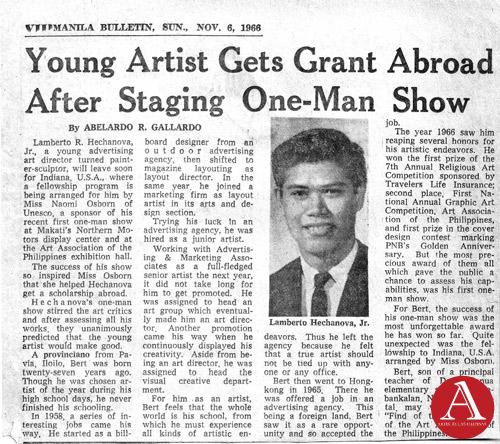 Lamberto R. Hechanova: Lost and Found
Lamberto R. Hechanova: Lost and FoundJune 2018-- A flurry of renewed interest was directed towards the works of Lamberto Hechanova who was reputed as an incubator of modernist painting and sculpture in the 1960s. His...
 European Artists at the Pere Lachaise Cemetery
European Artists at the Pere Lachaise CemeteryApril-May 2018--The Pere Lachaise Cemetery in the 20th arrondissement in Paris, France was opened on May 21, 1804 and was named after Père François de la Chaise (1624...
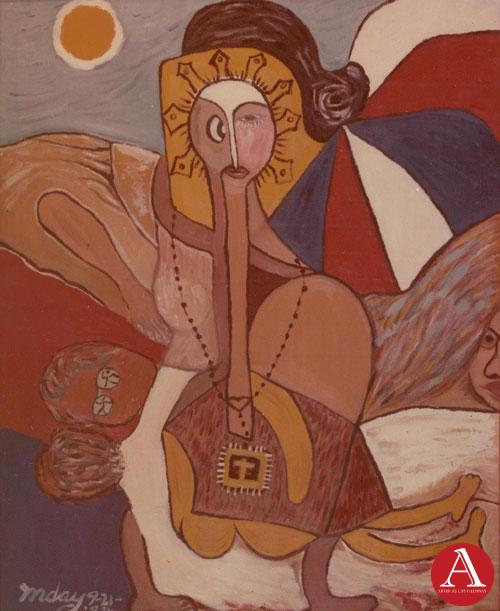 Inday Cadapan: The Modern Inday
Inday Cadapan: The Modern IndayOctober-November-December 2017--In 1979, Inday Cadapan was forty years old when she set out to find a visual structure that would allow her to voice out her opinion against poverty...
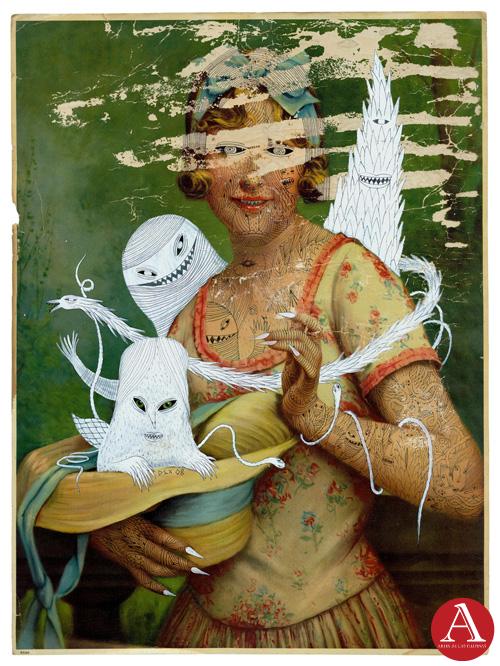 Dex Fernandez As He Likes It
Dex Fernandez As He Likes ItAugust-September 2017 -- Dex Fernandez began his art career in 2007, painting a repertoire of phantasmagoric images inhabited by angry mountains, robots with a diminutive sidekick,...
 Noel Soler Cuizon's Gesamtkunstwerk and Everything in Between
Noel Soler Cuizon's Gesamtkunstwerk and Everything in BetweenApril-May 2017—The public exhibition of Noel Soler Cuizon’s works began in 1987 when he was a member of Hulo, a group of alumni students of the Philippine Women’s...



